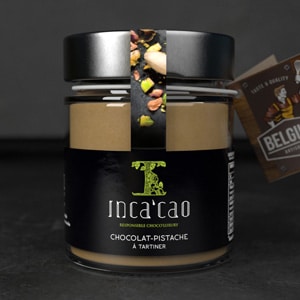Description
In this Inca Chocolate Hazelnut spread you will find:
10% Caprylic acid (C8) derived from coconut: other than long chain fatty acids, MCT’s (medium chain triglycerides) bypass the gastrointestinal tract completely and go straight to the liver for ketone production. It’s also called ‘the glucose of the fats’. There are eleven different fatty acids in coconut. Four of them are MCT’s: Caproic acid ( C6), Caprylic acid (C8), Capric acid (C10) and Lauric acid(C12). C12 is technically an MCT but the body processes it like a long chain fatty acid. While fasting or eating a fasting mimicking diet like a low carbohydrate or keto-diet the body becomes catabolic (breakdown) and will naturally start to create ketone bodies in the liver. There are 3 main types of ketone bodies: First the body will make Acetoacetate ( AcAc), it will then turn it into the Beta-hydroxybutyrate (BHB) and when there is enough BHB the rest will explode into Acetone which we exhale or urinate. C8 is the most bio-available to create ketones in the liver and will give the body an extra boost. Once fat adapted, even in a state of catabolism, BHB is muscle protective. that’s why you should not fast when you’re not fat adapted because of the increased muscle loss (turning muscle protein into glucose).
10% Collagen : after water, collagen is the most abundant nutrient in the body. It makes up 35% of the whole bodies protein content. After the age of 25 we reduce the production of our own collagen, therefore exogenous collagen is so critical for longevity. It is needed for bile production (33% glycine) to metabolise fat, skin elasticity and repair, your bones are 60% minerals but 90% of the protein matrix in your bones is collagen,… Our diet lacks of collagen because today we mainly eat muscle meat that is high in an amino acid methionine and low in glycine. To counter Methionine, glycine is needed. Collagen is rich in Glycine, proline, hydroxyproline amino acids.
10% Ghee : we make our own cultured ghee the ayruvedic. It is well tolerated for people with a lactose or casein sensitivity, packed with fat soluble vitamines (A,D,E,K2), Omega 3 (DHA and EPA), Conjugated linoleic acid (CLA) which is a natural trans fat with cancer protective benefits and reduced fat mass in healthy individuals. It is the richest source of the short chain fatty acid ‘butyrate’ which feeds the healthy gut bacteria.
Macadamia oil : Omega 7 ( Palmitoleic acid) is a lipokine (king of the fats). They work in conjunction with omega 3 and control what Omega 3’s do in the body. Cold water fish are high in omega 7 and 3 and this is the reason why the omega 3 in those fish are so bio-availible for our bodies, because of the Omega 7. Palmitoleic acid dramatically decreases the appetite and does this by the use of cholecystokinin (satiety hormone). They also improve overall insulin sensitivity (improved utilisation of carbohydrates) by preventing beta cell apoptosis of insulin cells (cells that work with insulin don’t die) and a better utilisation of insulin so that carbohydrates aren’t stored as much as fat. It also helps muscle cells utilize insulin better. This means that carbohydrates are being utilised more productively in the muscles and communicating better, rather than having elevated blood sugar levels for longer periods of time. It creates a massive reduction in CRP (C-reactive protein), dramatic reduction in triglycerides, low oxidation of LDL, increased HDL. Humans should have a ratio of 6:1:1 monounsaturated fatty acid (MUFA) to polyunsaturated fatty acids(PUFA) to saturated fatty acids (SFA). Macadamia nut oil contains 85% of MUFA and around 24% of it is palmitoleic acid. Mono-unsaturated fat, MTC and omega 3 ( especially EPA and DHA) are a dietary dream team when it comes to losing body fat.
hazelnut : vitamine E is an fat soluble vitamine. It is an antioxidant for the tocopherols familie. In 100gr of hazelnuts there is 15mg of Vit E. It is required for maintaining the integrity of mucous membranes and skin by protecting them from harmful oxygen free radicals. it also has 86% DV of manganese! it is huge contributor to enzymes that are antioxidant. It hugely improves inflammation marker and increases massively HDL cholesterol carriers.
Low Glycemic Index: apart from Type 1 and 2 diabetics, more than 50% of the population has a small resistance to insulin. Insulin is the most dominant hormone and is absolutely critical for health, it is responsible for multiple functions, one of it is glycolysis (glucose oxidation) . It’s counter hormone is Glucagon that is responsible for lipolysis (fat oxidation). If insulin is high, glucagon secretion is depressed completely in healthy individuals.
Prebiotic Soluble Fibre Polydextrose: This has a low caloric value: about 1 kcal/g, and it is widely used as a bulking agent and to replace the structure and texture of sucrose (table sugar). This soluble fiber has a glycemic index (GI) of 4 to 7.
Unlike other fibres such as: soluble chicory fibre (known as inulin with a GI of 14, maximum consumption 60g/day), soluble corn fibre (known as Resistant Maltodextrin with GI of 25, maximum consumption 45g/day) or soluble tapioca fiber (known as Isomalto-oligosaccharide with a GI of 35, maximum consumption 30g/day).
We decided to use this synthetic prebiotic fibre Polydextrose above those mentioned above and started lowering the use of those concentrated ‘natural’ fibres except for our caramel spreads. We stopped using the marketing tricks such as ‘All Natural…’. Honey, grains and bananas (ripe bananas have a GI of 130!) are also ‘Natural’ as well as beet and cane sugar, that’s why the excessive use of ‘Natural sweeteners’ causes insulin resistance and diabetes. Arsenic and Gasoline is also natural if we want to go this way! We are reducing the use of inulin, soluble corn -and tapioca fibre because it gives so much bloating and soft or loose stools, some have a high GI and the daily intake is so limited and gives a lot of stress on the body. Polydextrose has the highest daily intake of 90gr, is less taxing for the body and improves the gut flora and microbes much better by fermenting this prebiotic fibre to create the 3 main short fatty acids (acetate, propionate and butyrate) which can affect systemic fatty acid metabolism through modulating host gene expression and providing a substrate for cellular catabolic and anabolic reactions.
Natural sweetener:
Thaumatin is an African fruit, a protein that the body metabolises as a protein, therefore it leaves no trace like other sweeteners and is completely safe.
Compared to stevia and monkfruit this sweetener has a sweetness index of 3000 compared to sucrose (table sugar).
D-Ribose : Unlike glucose, which has a high glycemic index of 100, ribose has a negative glycemic index. In fact, ribose lowers plasma sugar levels, unlike 6-carbon sugars (table sugar)! Thus, while ribose is pharmacologically an anti-sugar and does not contain any glucose or fructose , it must be listed in Supplements Facts as a sugar. Chemically it is a sugar but functionally it does not act like a sugar because it is a 5-carbon sugar. Ribose is naturally created in our body, it is an absolute requirement to make ATP, which is our cells major energy molecule. When cellular ATP is low our cells are sick and cannot function. They cannot take care of their “housekeeping “ functions; they can’t make enzymes or muscle proteins or maintain their cell membrane ion gradients. In fact, low ATP levels can lead to cell death and premature aging. D-ribose also improves fatigue syndrome and fybromyalgia.
Erythritol: Is an natural alcohol sugar with a 4 carbon molecule. It is quite different from other alcohol sugars and is very safe. With only 6% of the calories of sugar, it still contains 70% of the sweetness. It essentially goes safely through your system untouched, with zero metabolisation because the body can’t break it down. There is no change in blood sugar or insulin levels when consuming erythritol because it has a glycemic index (GI) of only 1 unlike Glucose which has a GI of 100.
Allulose, is expected in our natural sweetener to upgrade our sweetener mix in the future. The tests within Inca’cao are already validated but unfortunately The Novel food approval in Europe has not given permission yet and this is expected only in 2021.
Scientific studies:
Macadamia oil
https://www.ncbi.nlm.nih.gov/pmc/articles/PMC5227969/
https://www.ncbi.nlm.nih.gov/pubmed/8006520
Polydextrose
https://www.ncbi.nlm.nih.gov/pmc/articles/PMC5509720/
https://www.intechopen.com/books/lipid-metabolism/polydextrose-in-lipid-metabolism
Ghee + CLA
https://www.ncbi.nlm.nih.gov/pmc/articles/PMC5947909/
https://www.ncbi.nlm.nih.gov/pmc/articles/PMC4964663/
https://www.ncbi.nlm.nih.gov/pubmed/15941017
https://www.ncbi.nlm.nih.gov/pubmed/15159244
Erythritol
https://www.ncbi.nlm.nih.gov/pubmed/8039489
D-ribose
https://www.ncbi.nlm.nih.gov/pmc/articles/PMC5959283/
https://www.ncbi.nlm.nih.gov/pubmed/17109576
Hazelnut
https://www.ncbi.nlm.nih.gov/pubmed/24124429
https://www.ncbi.nlm.nih.gov/pubmed/23761651






 Belfius Direct Net
Belfius Direct Net Credit card
Credit card iDEAL
iDEAL KBC/CBC Payment Button
KBC/CBC Payment Button Bancontact
Bancontact PayPal
PayPal SOFORT Banking
SOFORT Banking








